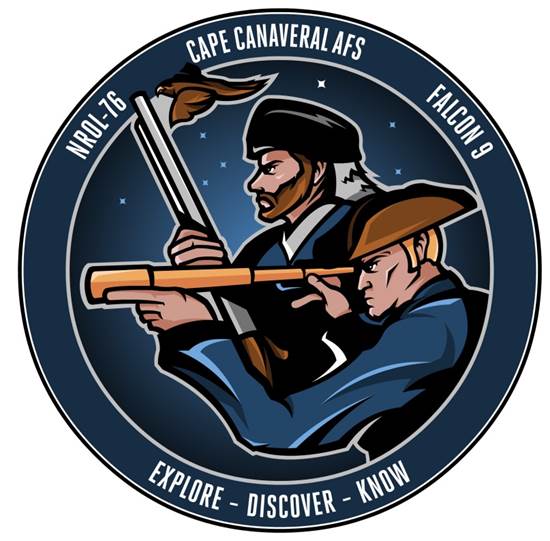
Working overnight on Florida’s Space Coast, SpaceX technicians transferred a two-stage Falcon 9 rocket from the company’s commercial hangar a quarter-mile up the ramp to launch pad 39A early Saturday, positioning the kerosene-fueled booster for liftoff Sunday with a classified payload for the U.S. government’s National Reconnaissance Office.
The 229-foot-tall (70-meter) all-new Falcon 9 rocket was lifted upright by a hydraulic erector mechanism shortly after 8 a.m. EDT (1200 GMT) Saturday to begin final checkouts before launch.
The NRO has released scant details on what will ride into space on top of the Falcon 9 rocket Sunday, other than disclosing via Twitter on Friday that the payload was designed, built and will be operated by the organization, which is responsible for the U.S. government’s spy satellites.
Codenamed NROL-76, the mission will be SpaceX’s first dedicated national security flight, a significant step toward the company’s goal of winning a larger share of lucrative launch contracts for the U.S. government’s pricey, sensitive military and intelligence-gathering spacecraft.
The mission has a two-hour launch window opening at 7 a.m. EDT (1100 GMT) Sunday. The weather outlook is favorable, with U.S. Air Force forecasters predicting an 80 percent chance of acceptable conditions at launch time.
A backup launch opportunity is available Monday.

The identity, purpose and target orbit of the payload mounted on top of the Falcon 9 rocket remain secret.
Hazard notices released to pilots and sailors indicate the launcher will turn northeast after lifting off Sunday, ruling out a geostationary orbit destination favored by the NRO’s eavesdropping signals intelligence satellites.
The northeasterly trajectory likely means the mission will put its payload in a low-altitude orbit a few hundred miles above Earth, or inject a satellite into a higher Molniya-type orbit, an elliptical egg-shaped loop around Earth that stretches as high as 25,000 miles (40,000 kilometers).
If the mission aims for a low orbit, the payload is likely a new type of NRO spacecraft, introducing fresh capability into the spy agency’s satellite fleet or proving out new technologies and sensors that could be used on future missions. If the higher Molniya orbit is where the Falcon 9 rocket is heading, SpaceX could be carrying a new relay satellite to pass high-resolution surveillance imagery from ground-pointing orbiting telescopes to intelligence analysts in nearly real-time.
See our earlier story for more information on the potential missions.
The NRO awarded the NROL-76 launch contract to SpaceX in a sole-source agreement, bypassing a competition with other launch providers like United Launch Alliance. The NRO first referenced a launch contract with SpaceX in 2013 during a congressional hearing — before the Falcon 9 rocket was certified by the Air Force to haul national security satellites — but the secretive agency did not publicly identify the mission codename and schedule for the launch until last year.
Most NRO missions launch on ULA’s Atlas 5 and Delta 4 rockets, and SpaceX will be eligible to win more NRO satellite deployment contracts later this year. The Air Force is managing head-to-head competitions between ULA and SpaceX for the rights to national security launches, and six upcoming flights with NRO payloads are to be competed in the coming months, along with seven Air Force missions.
SpaceX already won contracts to launch two GPS navigation satellites under the Air Force’s new competitive launch procurement strategy.

Saturday’s rollout came four days after SpaceX engineers conducted a customary preflight “static fire” test of the Falcon 9 rocket at pad 39A. The hotfire test Tuesday occurred without the NROL-76 payload aboard the launcher, a SpaceX policy change introduced after a Falcon 9 rocket exploded during a similar test in September 2016, destroying an Israeli-owned communications satellite.
After Tuesday’s static fire test, the Falcon 9 rocket returned to the hangar at the southern edge of pad 39A, a historic launch complex that was the departure point for all of NASA’s Apollo moon landing missions and most space shuttle flights. SpaceX now leases the facility from NASA.
Crews attached the Falcon 9 rocket with its top secret payload over the last few days.
SpaceX’s launch team will report to work before dawn Sunday to begin going through the Falcon 9’s preflight checklist.
Assuming the launch remains on track for the opening of Sunday’s launch window, the Falcon 9 launch conductor will poll the SpaceX team for a “go” for fueling of the two-stage rocket at 5:47 a.m. EDT (0947 GMT), followed by the start of tanking with RP-1 kerosene fuel around three minutes later.
Super-chilled liquid oxygen propellant, cooled to near its freezing point, will begin pumping into the Falcon 9 at T-minus 45 minutes.
The computer-controlled countdown will prep the rocket’s nine Merlin 1D main engines for ignition, transition the Falcon 9 to internal battery power, and pressurize the booster’s propellant tanks in the last 10 minutes of the countdown.
Hold-down clamps will release the Falcon 9 rocket once the vehicle’s computer runs the Merlin engines through a health check.
Riding 1.7 million pounds of thrust, the launcher will reach supersonic speed around a minute after liftoff, rocketing into the stratosphere before switching off the nine first stage engines at T+plus 2 minutes, 17 seconds. Three seconds later, pneumatic pushers will separate the first and second stage of the Falcon 9, and the upper stage’s single Merlin engine will fire at T+plus 2 minutes, 28 seconds.
The clamshell-like structure covering the clandestine NROL-76 payload will jettison at T+plus 2 minutes, 48 seconds, and then SpaceX’s webcast will cease coverage of the upper stage’s progress, with the rest of the ascent under a news blackout at the request of the NRO.
SpaceX is expected to continue its live video coverage of the first stage’s return to a landing site at Cape Canaveral Air Force Station. Soaring above the Atlantic Ocean, the 15-story booster will reignite some of its engines to steer back toward Florida, deploy grid fins for stability, and then extend four landing legs just before making a propulsive rocket-assisted vertical touchdown at Landing Zone 1, around 9 miles (15 kilometers) south of launch pad 39A.
If successful, the landing will be the fourth time SpaceX has recovered one of its rockets intact at Cape Canaveral for refurbishment and potential reuse. The company has landed a Falcon 9 first stage booster nine times overall, a tally that includes returns at sea.
Touchdown at Landing Zone 1 is scheduled for T+plus 8 minutes, 46 seconds.
Email the author.
Follow Stephen Clark on Twitter: @StephenClark1.



